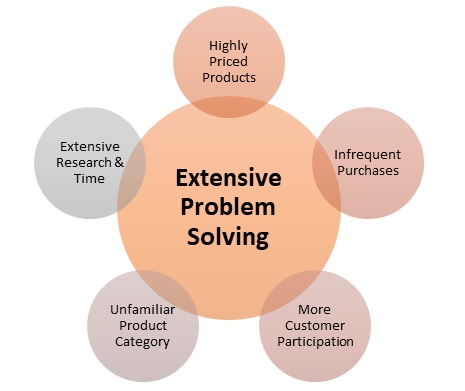- Business Concepts ›
- Marketing and Strategy ›
- Extensive Problem Solving
Extensive Problem Solving
Definition, Importance & Example
This article covers meaning & overview of Extensive Problem Solving from marketing perspective.
What is meant by Extensive Problem Solving?
Extensive problem solving is the purchase decision marking in a situation in which the buyer has no information, experience about the products, services and suppliers. In extensive problem solving, lack of information also spreads to the brands for the product and also the criterion that they set for segregating the brands to be small or manageable subsets that help in the purchasing decision later. Consumers usually go for extensive problem solving when they discover that a need is completely new to them which requires significant effort to satisfy it.
The decision making process of a customer includes different levels of purchase decisions, i.e. extensive problem solving, limited problem solving and routinized choice behaviour.
Elements of Extensive Problem Solving
The various parameters which leads to extensive problem solving are:
1. Highly Priced Products: Like a car, house
2. Infrequent Purchases: Purchasing an automobile, HD TV
3. More Customer Participation: Purchasing a laptop with selection of RAM, ROM, display etc
4. Unfamiliar Product Category: Real-estate is a very unexplored category
5. Extensive Research & Time: Locality of buying house, proximity to hospital, station, market etc.
All these parameters or elements leads to extensive problem solving for the customer while taking a decision to make a purchase.

Importance of Extensive Problem Solving
It is very important for marketers to know the process that customers go through before purchasing. They cannot rely upon re-buys and word of mouth all the time for acquiring new customers. The customer in general goes through problem recognition, information search, evaluation, purchase decision and post-purchase evaluation. Closely related to a purchase decision is the problem solving phase. A new product with long term investment leads to extensive problem solving from a customer. This signifies that not all buying situations are same. A rebuy is very much different from a first choice purchase. The recognition that a brand enjoys in a customer’s mind helps the customer to make purchase decisions easily. If the brand has a dedicated marketing communication effort, whenever a consumer feels the need for a new product, they instantly go for it.
To help customers in extensive problem solving, companies must have clear transparent communication. It is thus very important for marketers to use a proper marketing mix so that they can have some cognition from their customers when they think of new products. With the advent of social media, the number of channels for promotion have hugely developed and they require a clear understanding on the segment of customer that each channel serves. The communication channels should lucidly differentiate themselves from other brands so that they are purchased quickly and easily.
Example of Extensive Problem Solving
Let us suppose, that Amber wants to buy a High Definition TV. The problem being, she has no idea regarding it. This is a case of extensive problem solving as the amount of information is low, the risk she is taking is high as she is going with the opinion that she gathers from her peers, the item is expensive and at the same time it also demands huge amount of involvement from the customer. Similarly, buying high price and long-term assets or products like car, motorcycle, house etc leads to extensive problem solving decision for the customers.
Hence, this concludes the definition of Extensive Problem Solving along with its overview.
This article has been researched & authored by the Business Concepts Team which comprises of MBA students, management professionals, and industry experts. It has been reviewed & published by the MBA Skool Team. The content on MBA Skool has been created for educational & academic purpose only.
Browse the definition and meaning of more similar terms. The Management Dictionary covers over 1800 business concepts from 5 categories.
Continue Reading:
What is MBA Skool?About Us
MBA Skool is a Knowledge Resource for Management Students, Aspirants & Professionals.
Business Courses
Quizzes & Skills
Quizzes test your expertise in business and Skill tests evaluate your management traits
Related Content
All Business Sections
Write for Us